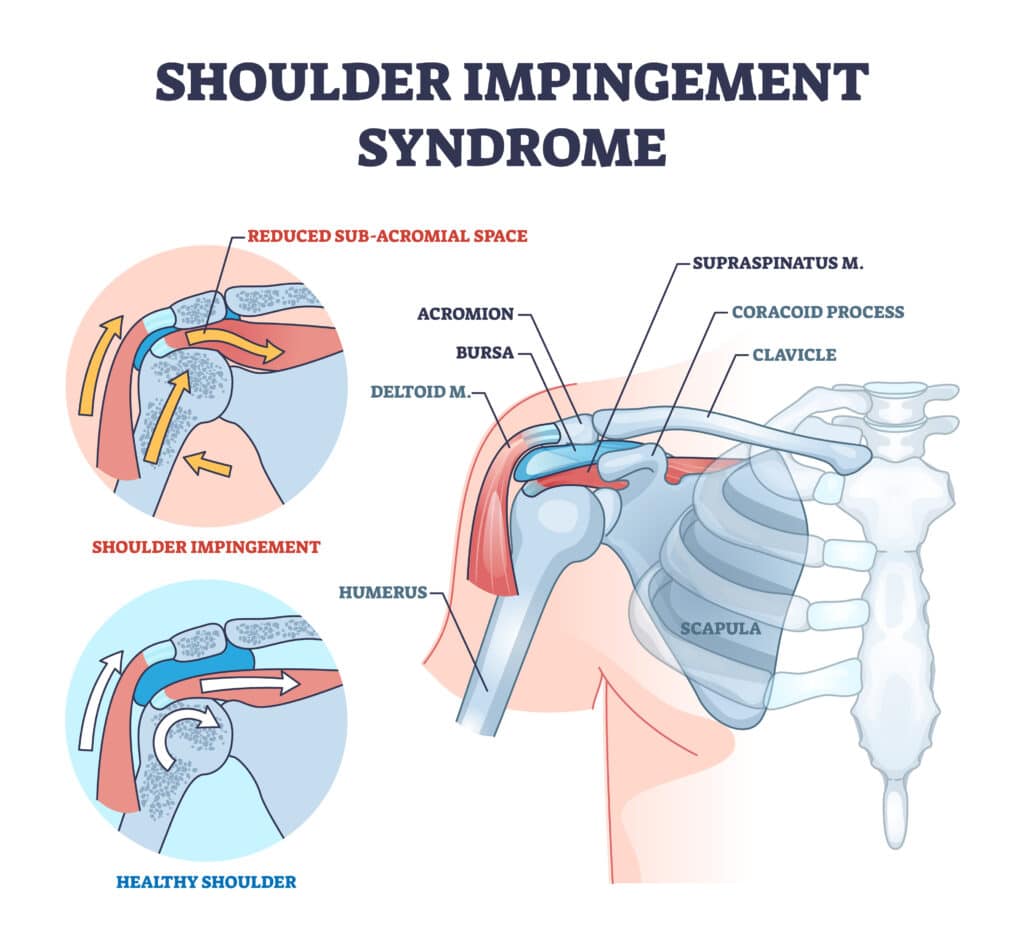Do you struggle with pain and stiffness in your shoulder when you lift your arm above your head or behind your back? Do you have trouble sleeping on your side because of the discomfort in your shoulder? If you answered yes, you might be dealing with shoulder impingement.
Shoulder impingement is a common problem that affects many older adults, especially those who engage in repetitive overhead activities, such as lifting, reaching, or throwing. Fortunately, shoulder impingement can be prevented and treated with good self-care and the right exercises.
As a physical therapist, I’ve helped many senior patients better manage and recover from shoulder impingement. It’s one of my favorite issues to teach about because it intersects with so many areas of daily life.
This article will explain shoulder impingement, what causes it, how to treat it, and what exercises to do for better outcomes when you have this common condition. By the end of this post, you will better understand the condition and how to manage it with simple and practical exercises.
What is Shoulder Impingement?
Shoulder impingement, also called subacromial impingement syndrome, is a condition where the rotator cuff tendons or other soft tissues like the bursa become pinched between the upper part of your arm bone (the humerus) and the acromion of your shoulder blade (the scapula) [1].
If you are unfamiliar with these terms, your rotator cuff is a group of four muscles that attach the humerus to the scapula, which helps stabilize and move your shoulder joint. The bursa is a fluid-filled sac that cushions the joint and reduces friction between bones and soft tissues.
When the space between the humerus and the acromion narrows, the rotator cuff tendons or bursa can become compressed or irritated. This slight change can lead to inflammation, pain, and reduced range of motion in your shoulder.
Shoulder impingement can affect one or both shoulders and often interferes with the daily activities of my patients. Simple activities like dressing, bathing, and reaching for things around the house can become painful and difficult.
The following illustration shows the basic anatomy of shoulder impingement:

What Causes Shoulder Impingement?
Many factors can contribute to shoulder impingement.
- Rounding the shoulders forward in a slouched posture can reduce the space between the humerus and the acromion, increasing pressure on the rotator cuff tendons or bursa.
- Muscle imbalances, especially weakness or tightness of the rotator cuff muscles, often cause problems. Imbalances can affect the alignment of your shoulder joint and cause the humerus to move abnormally.
- Repetitive overhead movements like lifting, reaching, or throwing often result in impingement. When done incorrectly or too often, these can irritate the rotator cuff tendons or bursa and lead to inflammation.
- Changes to the bones of your shoulder due to arthritis can narrow the space around the tendons of your rotator cuff.
- Bone spurs, even small ones, can lead to impingement, depending on where they develop.
While these are some of the most common causes I see in my clinic for shoulder impingement, it’s also essential to understand what impingement looks and feels like.
What are the Symptoms of Shoulder Impingement?

While the symptoms of shoulder impingement can vary from person to person, here are some of the most common signs to look for:
Pain in the front or side of your shoulder, especially when raising your arm above your head or behind your back, is one of the most apparent signs of a problem. In some cases, the pain may radiate to your upper arm.
Difficulty sleeping on your affected shoulder is also commonly reported. The extra pressure on your shoulder can cause discomfort, which may also prevent you from sleeping.
Many patients show stiffness or reduced mobility in their shoulder joint, especially when reaching overhead. Because of how the shoulder joint moves, raising your arm overhead can worsen impingement and make it difficult to perform daily activities or recreation.
Weakness or loss of strength in your arm is also common. Your rotator cuff muscles help support and move your arm. Any irritation or injury can affect the strength of your arm.
I’ve seen patients with one or more of these symptoms. In most cases, seniors tend to ignore symptoms until they reach the point that they are limiting everyday activities. For this reason, I always educate my patients on the importance of seeking help early if something doesn’t feel right in your shoulder.
How Is Shoulder Impingement Treated?
The exact treatment of shoulder impingement will be highly individualized based on the severity of your symptoms, how long you’ve been experiencing them, your health history, and your lifestyle.
It is often possible to treat shoulder impingement with conservative or non-invasive methods. Here are a few treatment methods that you should be familiar with if you’re struggling with shoulder impingement:
Relative Rest
Distinct from lying in bed and doing nothing, relative rest means staying as active as possible while reducing your symptoms. This “active” rest can help reduce the inflammation and irritation of the rotator cuff tendons or bursa, allowing them to heal while keeping you as active as possible.
Managing Inflammation
Inflammation is often the cause of pain in shoulder impingement. Applying an ice or heat pack, taking over-the-counter medications such as ibuprofen, and avoiding leaning on your affected side can reduce your symptoms and promote healing.
Gentle Exercises
Keeping the causes of shoulder impingement in mind, it makes sense that exercises and stretches to improve mobility and strength in your shoulder can be effective for managing symptoms and recovery.
Using exercise to improve your posture during sitting, standing, and reaching is one of the most easily understood illustrations of the value of exercises for impingement.
Once recovery is complete, patients often say exercise was the most critical part of their treatment. But if you’re new to exercise, where should you start?
Shoulder Impingement Exercises For Older Adults
Now that we’ve established how exercise can help prevent and treat shoulder impingement, let’s dive into some of my favorite exercises for helping older adults manage and recover.
Keep in mind that no single exercise works for every person. You may respond to exercise differently than others, so taking what works for you and leaving the rest is essential, especially if you encounter pain.
If specific exercises cause pain or you are unable to get the pain under control, be sure to consult with a medical provider, such as a physical therapist.
Basic Guidelines Before Exercise
Before you try any exercises for shoulder impingement, I recommend following these general guidelines:
Start with low-intensity exercises and gradually increase based on your response. This can help you avoid overloading or straining your shoulder joint and allow it to adapt to the exercise. You can start with one or two sets of each exercise and increase as you feel comfortable.
Stop any exercise that causes sharp pain in your shoulder. Pain indicates that you could be doing the exercise incorrectly or that the activity is too intense for your needs. You should only feel mild stress or discomfort in your shoulder during any workout, not pain.
Remember to breathe normally while you exercise. It’s easy to get tense if you’re experiencing pain, but normal breathing can help you relax your muscles and avoid holding unnecessary tension in your shoulders.
Here are some of my favorite exercises to improve shoulder impingement and mobility.
Pec Doorway Stretch
Tight chest muscles can pull the shoulders forward and inward, reducing the space between the humerus and the acromion and increasing the risk of shoulder impingement. This exercise stretches the chest muscles (pectoralis major and minor) and helps relieve tension on the shoulder joint.
You will need a doorway or a wall corner to do this exercise.
- Stand before the doorway or wall corner and place your arm along the frame or wall at about shoulder height.
- Lean forward slightly until you feel a gentle stretch in your chest and front of your shoulder.
- Hold this position for 15 to 30 seconds, then relax.
- Repeat this exercise 2 to 3 times, adjusting the height of your arms as needed.
Tip: Adjust the height of your arm depending on how comfortable the exercise is. Generally, a lower position will be more tolerable than a higher one.
Foam Roller Backstroke
Pain with overhead motion is one of the biggest issues with shoulder impingement, and the weight of gravity can make overhead movements even more challenging. This exercise helps you achieve overhead shoulder movement without the weight of gravity to get full shoulder motion.
- You will need a foam roller or a rolled-up towel to do this exercise.
- Lie on your back with your knees bent and your feet flat on the floor.
- Place the foam roller or towel vertically under your upper back, ideally supporting your head and pelvis.
- Slowly raise one arm overhead as far as you can comfortably while keeping the opposite arm at your side, then slowly lower your arm to your side while raising your opposite arm.
- Repeat this motion for 10-20 repetitions on each side.
- Tip: Keep your back against the roller and avoid shrugging your shoulders during the exercise.
Cat to Cow
When you have limited motion in your upper back, it can affect the movement of your shoulder joint and cause compensatory patterns that can contribute to shoulder impingement. This exercise increases the mobility of your upper back (thoracic spine) for improved posture and alignment of your shoulder joint.
- You will need a mat or a soft surface to do this exercise.
- Start on your hands and knees, with your hands directly under your shoulders and your knees under your hips.
- Slowly round your back as far as you can and bend your head down. Imagine you are raising your upper back toward the ceiling.
- Pause briefly, then slowly arch your back and bring your head up. Imagine you are pressing your chest toward the floor.
- Repeat this movement 10 to 20 times.
- Tip: Keep your arms straight during the exercise and maintain the alignment of your hips, knees, shoulders, and hands.
T’s and Y’s
The rotator cuff muscles help support your shoulder joint and prevent impingement by keeping the humerus in the socket. This set of exercises strengthens the rotator cuff muscles, which can help improve posture and shoulder stability.
- You will need a mat, exercise ball, or a soft surface to do this exercise.
- Lie on your stomach on the exercise ball with your arms by your sides and palms facing down. Your knees can remain bent, bracing the ball.
- For T’s: Set your arms directly out to your side at shoulder level, then lift both arms up in a ‘T’ shape while squeezing your shoulder blades together as you lift. Pause, then lower back to the starting position.
- For Y’s: Set your arms overhead in a ‘Y’ position, then lift both arms straight up until they align with your body while squeezing your shoulder blades together as you lift. Pause, then lower back to the starting position.
- Repeat 10-20 times for each exercise or until the muscles around your shoulder blades feel fatigued.
- Tip: For most people, I’s are easier than T’s, and T’s are easier than Y’s, so focus on the movement that challenges you without causing pain.
Having used these exercises and many others with older adults of all backgrounds, I can say there is no single best exercise for everyone. If you have any questions or concerns about shoulder impingement or which exercises are best for you, I recommend speaking to your doctor or physical therapist for assistance.
Key Takeaways
- Shoulder impingement is a condition where the rotator cuff tendons or other soft tissues become pinched between the upper part of the arm bone and the shoulder blade.
- Common causes of shoulder impingement include slouched posture, muscle imbalances, repetitive overhead movements, changes to the bones due to arthritis, and bone spurs.
- Symptoms of shoulder impingement include pain in the front or side of the shoulder, difficulty sleeping on the affected shoulder, stiffness or reduced mobility in the shoulder joint, and weakness or loss of strength in the arm.
- Treatment for shoulder impingement can include relative rest, managing inflammation, and gentle exercises to improve mobility and strength in the shoulder.
- Some exercises that can help with shoulder impingement include the pec doorway stretch and the wall angel.
- It’s important to start with low-intensity exercises. Listen to your body, and consult a medical provider if you experience pain.
FAQs
What are the primary functions of the rotator cuff?
The rotator cuff is a group of four muscles that stabilize and move the shoulder joint by attaching the humerus to the scapula.
How does poor posture lead to shoulder impingement?
Slouched or forward-rounded shoulders can reduce the space between the humerus and the acromion, increasing pressure on rotator cuff tendons or bursa.
Are certain sports or activities more likely to cause shoulder impingement?
Activities or sports involving repetitive overhead movements, like swimming, tennis, or baseball, can increase the risk of shoulder impingement.
Can exercises make shoulder impingement worse?
Exercises can exacerbate the symptoms if done incorrectly or if they strain the shoulder too much. It’s essential to start with low-intensity workouts and seek guidance if pain persists.
How long does it typically take to recover from shoulder impingement with proper care?
Recovery time varies depending on the severity, individual health factors, and adherence to treatment. However, with consistent exercises and appropriate care, many patients see improvement within a few weeks to a couple of months.
References
- Creech JA, Silver S. Shoulder Impingement Syndrome. [Updated 2023 Apr 17]. In: StatPearls [Internet]. Treasure Island (FL): StatPearls Publishing; 2023 Jan-.
- Koester, M. C., George, M. S., & Kuhn, J. E. (2005). Shoulder impingement syndrome. The American journal of medicine, 118(5), 452–455. https://doi.org/10.1016/j.amjmed.2005.01.040
- Garving, C., Jakob, S., Bauer, I., Nadjar, R., & Brunner, U. H. (2017). Impingement Syndrome of the Shoulder. Deutsches Arzteblatt international, 114(45), 765–776. https://doi.org/10.3238/arztebl.2017.0765





